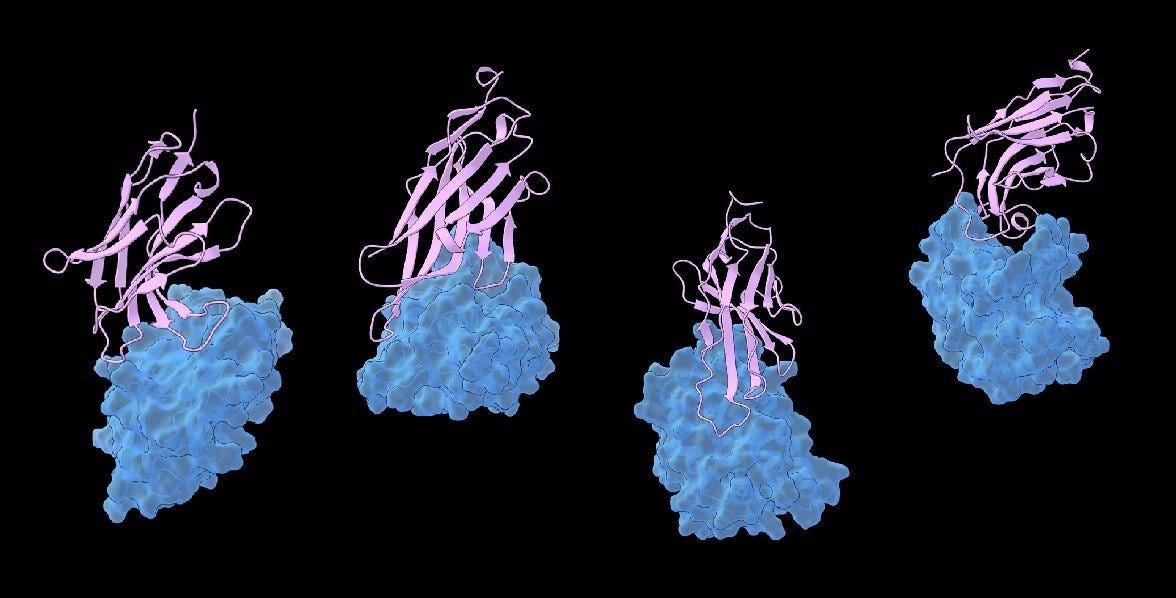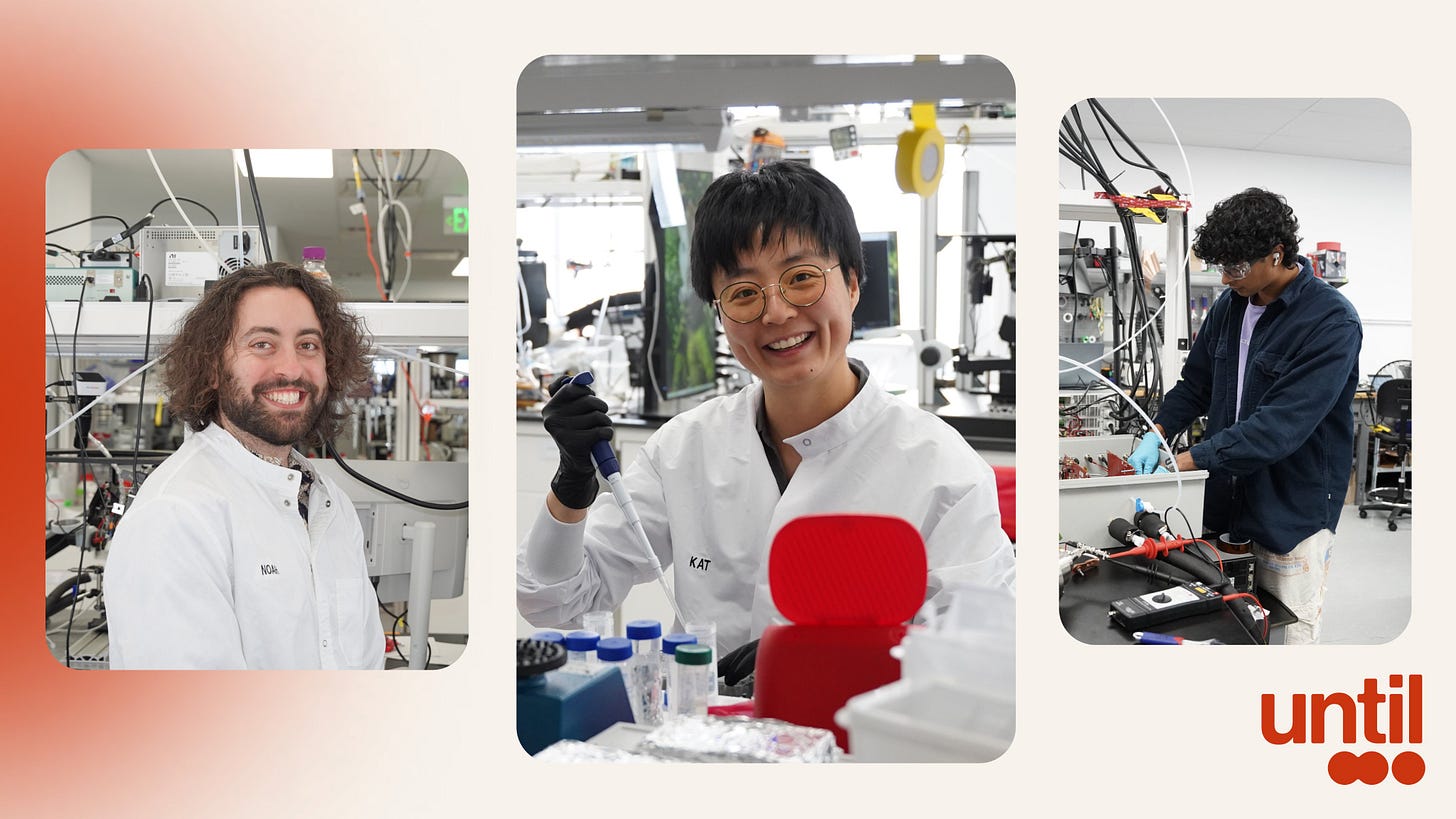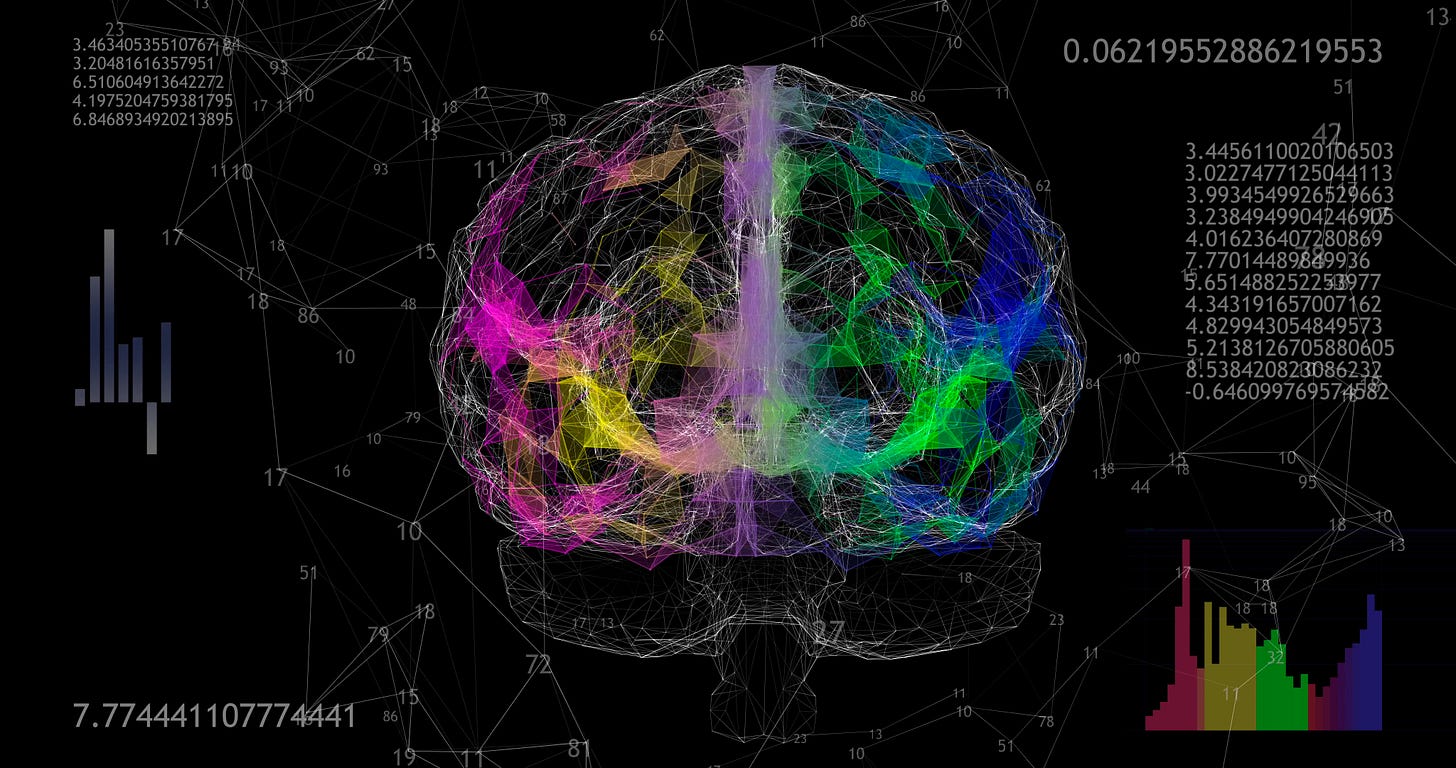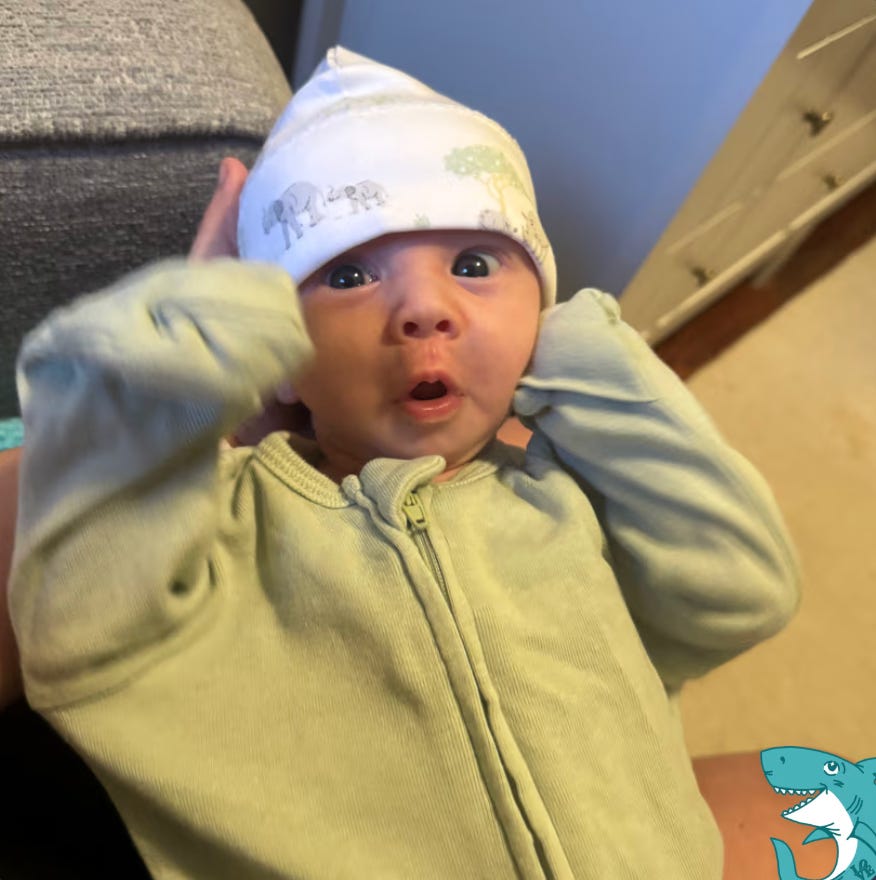Weekly Dose of Optimism #163
Germinal (+bridge recombinase), cryo organs, Sila anodes, brain is not computer, hallucination-less psychedelics + Nate the Great
Hi friends 👋 ,
Happy Friday and welcome back to our 163rd Weekly Dose of Optimism. Dan is once again traveling around our great country slinging creatine gummies, so Packy here to fill in and bring you the Dose.
Let’s start with a PSA: don’t use Meta’s new slop machine, Vibes. It’s the company’s attempt to build The Entertainment from Infinite Jest, something that in the book is so entertaining that people can’t stop watching it and die. Take it from the man himself: “Like, at a certain point we’re gonna have to build up some machinery, inside our guts, to help us deal with this. Because the technology is just gonna get better and better and better and better. And it’s gonna get easier and easier, and more and more convenient, and more and more pleasurable, to be alone with images on a screen, given to us by people who do not love us but want our money.”
But the good news is, there’s lots of good news this week to drown it out. We have a lot of Arc, some cryopreservation, American anodes, a potential cure for Huntington’s Disease, a dash of Michael Levin and Anil Seth, and a menu of new psychedelics. Plus, let’s all support Nate the Great in his fight against cancer. What a week for the optimists.
Let’s get to it.
Today’s Weekly Dose is brought to you by... Bland
AI is calling. Ring ring. Hello? It’s Bland, the literal voice behind Fortune 500s.
Heard of Bland yet? It’s the world’s most powerful AI phone-calling agent. Chances are, you’ve already spoken to it without even noticing.
Enterprises are using it to handle millions of calls, texts, and webchat interactions 24/7 – all while perfectly representing their brand. From a single dashboard you can:
Build agents with any voice and personality, for any possible use case. Just define guardrails to control its behavior and plug in any of your external tools. Done.
Deploy your brand’s AI across every department from sales to operations to support with a single click. It will dynamically respond to any caller’s language, self-improve, and scale infinitely.
Track performance of campaigns, extract data, and watch it score a higher CSAT than human reps* – all while slashing costs.
Pretty wild, huh? Here, give it a call yourself.
Or Not Boring readers can get exclusive access to an even more advanced version here.
(1) Efficient generation of epitope-targeted de novo antibodies with Germinal
Brian Hie, Xiaojing Gao, and Santiago Mille Fragoso from Stanford and Arc Institute
Germinal centers on solving a fundamental challenge in computational antibody design: how to create molecules that are both binding the intended targets and biologically realistic. Previous approaches using structure prediction alone produced rigid, unnatural interfaces, while sequence-based methods lacked the structural precision needed for specific binding.
Another week, another Arc Institute drop.
Researchers at Arc and Stanford teamed up to release Germinal, a model for AI-designed antibody molecules. As one of the paper’s co-authors, Santiago Mille, wrote, “The ability to design antibodies against any protein of interest has major implications for medicine, biotech, and basic science.”
Germinal uses two machine learning systems - AlphaFold Multimer and IgLM to generate de novo (from scratch) antibodies tailored to bind specific epitopes on proteins. These antibodies are entirely computationally designed.
The team achieved nanomolar binding affinities (a measure of how tightly the antibody binds to its target) that are strong enough to be biologically relevant (used in therapeutics or diagnostics) for several challenging protein targets, including:
Spike protein of SARS-CoV-2: the virus causing COVID-19
PD-L1: a protein involved in immune regulation, often targeted in cancer therapies
VEGFR2: a protein linked to blood vessel growth, relevant in cancer and other diseases
Typically, antibody discovery involves screening thousands of candidates through experiments. Germinal significantly reduces the need for extensive lab-based testing, which can both speed up discovery timelines from months or years to weeks, which can be incredibly important in combating infectious diseases, and expands the universe of researchers able to work on to smaller labs and companies.
This seems to be a consistent pattern in AI for bio: models can dramatically reduce the time and cost it would take to run experiments in the lab. In this case, Germinal or one of its offspring (they’re open sourcing it) might be used to develop new diagnostics and fight infectious diseases and cancer.
Can’t wait to see what Arc does next week.
(jk, ed note: yesterday, Patrick Hsu’s lab at Arc published a paper in Nature showing “that bridge recombinase technology is capable of large-scale genomic rearrangements in human cells.” With CRISPR, a miracle technology itself, scientists can edit fewer than 100 DNA bases at a time. With this technology, they can edit a million bases at a time. Hsu tweeted that “The reason gene editing hasn’t transformed human health is that current gene editing technologies like CRISPR are very limited.” His implication being that bridge recombinase technology will be the thing that lets gene editing transform human health.)
As incredible as Arc’s specific breakthroughs have been, what’s more notable is how many breakthroughs the young organization has made in such a short time. Stripe cofounder Patrick Collison, who cofounded Arc, shared some thoughts on that here.
Can’t wait to see what Arc does later today.
(2) Laura Deming’s Until Labs Raises $58 million for Cryopreservation
reversibly cryopreserve human organs ->
help transplant patients + build sustainable business ->
accelerate R&D for whole body cryo
Just in case progress in biology doesn’t keep up its current torrid pace, we can wait.
Laura Deming realized at age 8 that we were all going to die of a disease called aging. Unlike most eight-year-olds, she started doing something about it almost immediately. At 12, she joined Cynthia Kenyon’s lab at UCSF, where Kenyon had successfully increased the lifespan of C. elegans worms by a factor of ten through genetic engineering. By 14, she was at MIT studying physics. At 17, she dropped out to become an early Thiel Fellow and start the Longevity Fund.
Now, after more than a decade of investing in longevity companies, Deming is building something herself: Until, which just raised a $58M Series A led by Founders Fund.
Until is building a “pause button for biology,” trying to make one of the most foundational sci-fi ideas in the book, cryopreservation, a reality. Practically every space-based sci fi story involves cryo because, even near light-speed, the journeys are so long. Freeze yourself now, wake up fresh on a new world in a millennium or two.
We’re not quite there yet, so Until is starting by tackling more pressing and commercial needs. First, it’s going after organ donation, where most organs remain viable for only hours after procurement: 4-12 for hearts, lungs, and livers, 24-36 for kidneys. Then, it’ll do medical hibernation, giving patients with terminal diseases the option to pause their biological clock until cures are developed.
Even these more modest milestones sound incredibly sci-fi, but Until has already demonstrated recovery of electrical activity in cryopreserved rat brain tissue, the first report of action potentials in cryopreserved and rewarmed acutely resected neural tissue. They’re using a combination of novel cryoprotective agents, custom electromagnetic rewarming systems, and surgical protocols to cool tissue to -196°C (where molecular motion essentially stops) and then bring it back.
The key insight is elegant. The rate of molecular motion and chemical reactions can be controlled with a single knob: temperature. We already do this with embryos for IVF. Until is working to scale the same idea from tiny embryos to whole organs and, eventually, entire organisms.
Here at the Weekly Dose, we love a good long-term Master Plan. Even if this one takes centuries to play out, now we can be there to celebrate when it does.
(3) Huntington’s disease successfully treated for first time
From BBC
One of the cruellest and most devastating diseases – Huntington’s – has been successfully treated for the first time, say doctors.
The disease runs through families, relentlessly kills brain cells and resembles a combination of dementia, Parkinson’s and motor neurone disease.
An emotional research team became tearful as they described how data shows the disease was slowed by 75% in patients.
What a week for biotech!
Huntington’s Disease is one of the worst we humans face. Currently, it’s a long, slow death sentence that impacts 30,000 Americans (with a further 200,000 at risk) and about 5 out of every 100,000 people of European descent. There hasn’t been an effective treatment for the disease. People get it in their 30s or 40s and face a decline over 10-30 years until death.
On Wednesday, though, scientists at a company called uniQure announced incredibly promising results from a study: its gene therapy, paired with brain surgery, slowed the progression by 75% after 36 months in patients who received it. It also slowed decline of functional abilities in patients by 60%. They are hopeful that doing the treatment earlier, before the disease sets in, may eliminate it entirely.
UniQure plans to submit its application to the FDA in 2026, and hope to launch the therapy later next year if successful.
What a miracle, man.
Operations will initially support 2-5 GWh of capacity with the capability to expand up to 250 GWh within five years and become the largest anode production facility in the world. By manufacturing domestically at unprecedented scale, Sila is replacing graphite, a critical mineral overwhelmingly sourced from China, with a higher-performing, American-made alternative at a time when U.S. manufacturers are acutely focused on cutting supply chain vulnerabilities.
In the Electric Slide, we argued that America is lagging in manufacturing the key components of the Electric Stack — batteries, magnets & motors, power electronics, and embedded compute — and that in order to compete in the future, we would need to innovate on new chemistries and materials, and make them here.
On Tuesday, Sila made a step in that direction, announcing that it opened the nation’s first automotive-scale silicon anode plant, producing Si/C instead of graphite anodes.
The company, which is backed by Sutter Hill, 8VC, Mercedes-Benz, In-Q-Tel, the DOE, Coatue, Tiger, Bessemer, BlackRock, Fidelity, T. Rowe Price and… Jared Leto, will start at 2-5 GWh of capacity focused on “customer applications, including electric mobility, consumer electronics, drones, AR/VR, and satellites.” If successful, it has the ability to expand two orders of magnitude to 250 GWh.
250 MWh seems… aggressive, given that it would represent over 8% of global battery manufacturing capacity based on the IEA’s current estimate of 3 TWh, but given the rate that demand for batteries is growing, it will hopefully be the first of many such announcements.
Every new battery chemistry comes with some advantages and disadvantages in the early days. On the pros side, Si/C offers higher specific capacity and energy density, which means more range or smaller packs (~20% better), and may be able to charge up to 2x faster. But Si/C will initially be more difficult to engineer and manufacture, leading to lower yields and higher $/kWh cost.
The question for Sila will be if they can dial in the engineering and manufacturing enough as they scale to move from high-end uses (like Mercedes EVs) to become a mass alternative to Chinese-dominated chemistries. We are rooting for them.
(5) Your Brain Isn’t a Computer and That Changes Everything
Theories of Everything with Curt Jaimungal ft. Anil Seth and Michael Levin
We’ve forgotten that the idea of the brain as a computer is a metaphor and not the thing itself. - Anil Seth
One of my least favorite ideas in the AI discourse is that our brains are merely computers, and therefore, AI will be able to do everything we can.
I railed against it in Modern Magnificenza, focusing on Ilya Sutskever’s University of Toronto Commencement Speech in which he argues:
Slowly but surely - or maybe not so slowly - AI will keep getting better, and the day will come when AI will do all the things that we can do. Not just some of them, but all of them. Anything which I can learn, anything which anyone of you can learn, the AI will do as well.
How do we know this by the way? How can I be so sure of that?
The reason is that all of us have a brain, and the brain is a biological computer. That’s why. We have a brain. The brain is a biological computer. So why can’t a digital computer, a digital brain, do the same things? This is the one sentence summary for why AI will do all of those things. Because we have a brain, and a brain is a biological computer.
If that is the one sentence summary for why AI will replace us, then the notion rests on shaky ground.
In this excellent episode of Theories of Everything, neuroscientist Anil Seth and biologist / bioelectricist Michael Levin agree that the metaphor of brain-as-computer misses the messy, emergent, and context-dependent nature of real minds.
Seth argues that consciousness can’t be separated from the living, biological substrate. The brain isn’t just information processing that can be ported to silicon.
Levin disagrees that consciousness is substrate-dependent, but for a different, and, if I may say so, more beautiful, reason than Sutskever and co. He suggests that with the right interfaces, computers may be able to tap into the same deep, platonic layers of reality that biology does.
Look, anything I’m going to write here is going to mangle what these two geniuses are trying to say, but if you want to expand your mind listening to a conversation on mind (and xenobots, compositional agents, emergence, and much more) throw this one on.
You can read Curt’s thoughts on this topic, and on many of the mind-altering conversations he hosts, on his substack:
(6) A Startup Used AI to Make a Psychedelic Without the Trip
Emily Mullin for WIRED
Mindstate’s idea is to use this “psychedelic tofu” as a base that will be combined with other drugs to achieve precise states of consciousness. For its first combination, DiNardo says, the company is aiming to make a drug that reduces anxiety, increases insight, and upregulates aesthetic perception.
Dan’s OOO. No rules. We’re doing a sixth.
We’ve covered the promise of psychedelics in both treating mental health conditions (and in general) many times here in the Dose and in Not Boring. The world might be a better place if everyone just took a chill pill.
… which sounds like exactly what a startup called Mindstate is developing. Mindstate is one of a number of companies working to create pyschedelics without hallucinations. More people, they believe, would be able to access the benefits of psychedelics if they weren’t scared off by the drugs’ most extreme effects, and the FDA might be more willing to approve drugs that can be tested in double-blind studies. Last year, they rejected MDMA-assisted therapy in part because… if you’re taking MDMA, it’s pretty clear whether you’re in the control group or not.
Mindstate’s first drug candidate, MSD-001, is “a proprietary oral formulation of 5-MeO-MiPT, also known by the street name moxy. In Phase I trial results shared with WIRED, the drug was safe and well tolerated at five different doses in 47 healthy participants.” According to Mindstate CEO Dillan DiNardo:
Our first new “emotion in a bottle”: tranquil insightful beauty. An MSD-001 combo designed to reliably enhance aesthetic perception, without hallucinations. This state occasionally flickers in compounds like DOI, 2C-B, or mescaline. When people experience this effect, they see a new beauty in the everyday world around them. If the effect volume is a little too high, people say things like, “The legs of that chair - how miraculous their tubularity, how supernatural their polished smoothness!” (actual quote)
The goal, he says, is to build many psychoactive effects on top of MSD-001. “If successful,” he tweeted, “psychiatry would gain for mental states what CRISPR gave genetics, what mRNA gave vaccines, and what CAR-T gave immunology: a programmable substrate.”
Dillan, please reply to this email if you’re looking for trial participants.
Note: pairs well with Dan Brown’s new book, The Secret of Secrets.
Bonus: Nate the Great
A couple of weeks ago, Matt, a Not Boring reader from Philly, sent me an email. He wanted to tell me about his son, Nate the Great, and to spread the word about his family’s fight against cancer.
Nate was born on May 2nd. On June 20th, they found out he had a brain tumor.
Thanks to the team at CHOP, Matt said Nate is now doing “remarkably well.” CHOP is awesome - my brother Dan had open heart surgery there when he was a baby.
Nate, Matt, and their family are raising money for CHOP to fight pediatric cancer as part of the Children’s Hospital of Philadelphia Parkway Run & Walk. The run is this Sunday, September 28th, and while Team Nate the Great is already crushing it with nearly $65k in donations, good for 2nd among all teams, I was hoping we could all team up to push them even higher, maybe even into first place.
As a Philly native, parent to two little kids, and brother to a beneficiary of CHOP’s miracle working (whose dad’s birthday is June 20th), I donated, and I would love to help them blow out their goal and help CHOP and others end pediatric cancer for good.
F*ck cancer. Go Nate.
Have a great weekend y’all.
Thanks to Bland for sponsoring. Go get your very own phone-calling agent.
We’ll be back in your inbox with a Deep Dive next week.
Thanks for reading,
Packy + Dan










Well done- thanks
Go Nate! 🦈💙